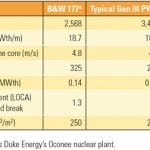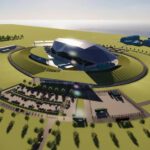As the Daiichi nuclear crisis has governments around the world reconsidering their nuclear-heavy energy plans and scrutinizing the safety of existing reactors and third-generation designs, several developers are touting the merits of small modular reactors (SMRs). A growing number of SMR developers are considering applying for design certification from the U.S. Nuclear Regulatory Commission (NRC). Among them are NuScale Power, with its 45-MW modular units, and Babcock & Wilcox, proposing a 125-MW mPower design. (For more on these plans, see “Nuclear Power in the Shadow of Fukushima,” p. 66) Joining that list are two new designs announced earlier this year: Holtec International’s 140-MW modular reactor and Westinghouse’s 200-MW integrated pressure water reactor.
Holtec in February said that the proof-of-principle studies of its HI-SMUR 140 were completed. The reactor’s core is located completely underground, operated by gravity-induced flow instead of a reactor coolant pump. Developers say it does not rely on offsite power for shutdown, and it can be installed as a single unit or a cluster at a site. “The waste heat from HI-SMUR’s power generation can be rejected through a water cooled or air cooled condenser or a combination thereof,” Holtec said in a statement. “Eliminating the reactor coolant pump and the need for emergency or off-site power to cool the reactor core in the event of a forced shutdown, are among the distinguishing design features of HI-SMUR that define its mission of utmost safety and security.” Among other features are its small footprint, a 24-month construction cycle, a miniscule site boundary dose, large inventory of coolant in the reactor vessel, and its modularity.
Holtec plans to fund development of the reactor itself—bypassing the fate of the Oregon State University–developed NuScale SMUR. NuScale Power earlier this year stopped work on contracts and has since laid off most of its 100-person workforce after its primary investor firm, the Michael Kenwood Group, was hit with a lawsuit by the Securities and Exchange Commission on allegations that it was improperly diverting investors’ money. Employing a handful of executives, NuScale says it will continue to work toward submitting an application for design certification next year. Holtec, which is in the process of submitting documentation for intellectual property protection under U.S. and international law, also plans to seek license application by the close of 2012.
Earlier in May, the Shaw Group announced it would provide phase one engineering support for the SMR, developing the conceptual design of the balance-of-plant and support systems to advance the reactor toward eventual commercial application. Shaw also plans to prepare an overall design and support license activities.
Echoing other SMR developers, Westinghouse’s SMR design presents “few accident scenarios” because it has no active safety systems and the smaller design has “fewer penetrations of its reactor and containment vessels, fewer vessels, and fewer pumps,” Michael Anness, manager for advanced reactors at the company, told attendees at a Platts-sponsored SMR conference in May.
The reactor’s primary components—drawn from the company’s third-generation AP1000 design—are located inside the reactor pressure vessel, and it is designed to be completely fabricated in the factory and shipped by rail. Westinghouse said the core, at the bottom of the module, is derived from a partial-height 17 x 17 fuel assembly used in the AP1000, and the reactor vessel internals are modified for the smaller core and to provide support for the internal control drive rod mechanisms (Figure 6).
 |
| 6. A small package. Westinghouse’s unnamed 200-MW integrated pressure water reactor features core and reactor vessel internals that are derived from its AP1000, a third-generation design. Horizontally mounted axial-flow canned motor pumps provide the driving head for the reactor coolant system. The design also features a compact steam generator and pressurizer integrated into the reactor vessel head, which eliminates the need for a separate component. Courtesy: Westinghouse |
This May, reacting to statements by NRC Chair Gregory Jaczko that the commission would not proceed with design certification for Westinghouse’s AP1000 until questions concerning the reactor design’s shield building and containment peak accident pressures were resolved, Westinghouse said the NRC’s discovery of new issues—“none of which were safety significant”—was being “misinterpreted and sensationalized.”
The company’s design has been under increased scrutiny following the Daiichi accident, and Westinghouse has been working—as have many nuclear power vendors—to offer products that improve safety at nuclear plants. The company recently launched an emergency fuel pool cooling system that keeps spent nuclear fuel cool in emergency situations (or in temporary mode during refueling outages), including loss of plant power.
The system consists of a permanently installed “primary” cooling loop located inside the reactor building or spent fuel pool building and a mobile “secondary” cooling loop. The secondary cooling loop is stored offsite and then located outside the reactor building for either emergency or pre-planned use. “This approach reduces the time required for system assembly and startup, which is especially important during emergency situations, and eliminates the need to enter the reactor building,” Westinghouse said. The system includes mobile diesel generators, air compressors, switchgear and other support equipment required to operate the stand-alone system.
—Sonal Patel is POWER’s senior writer.










